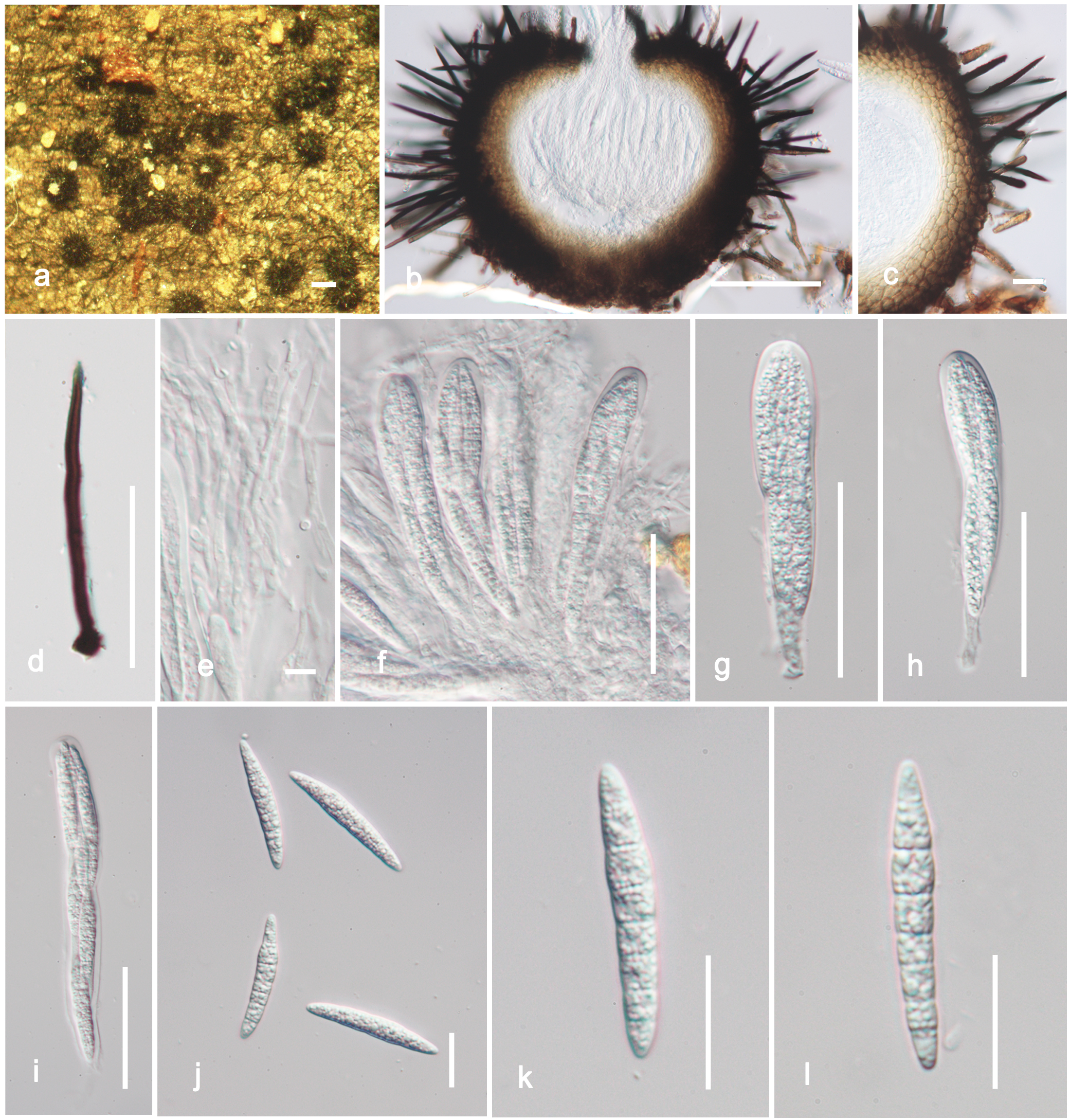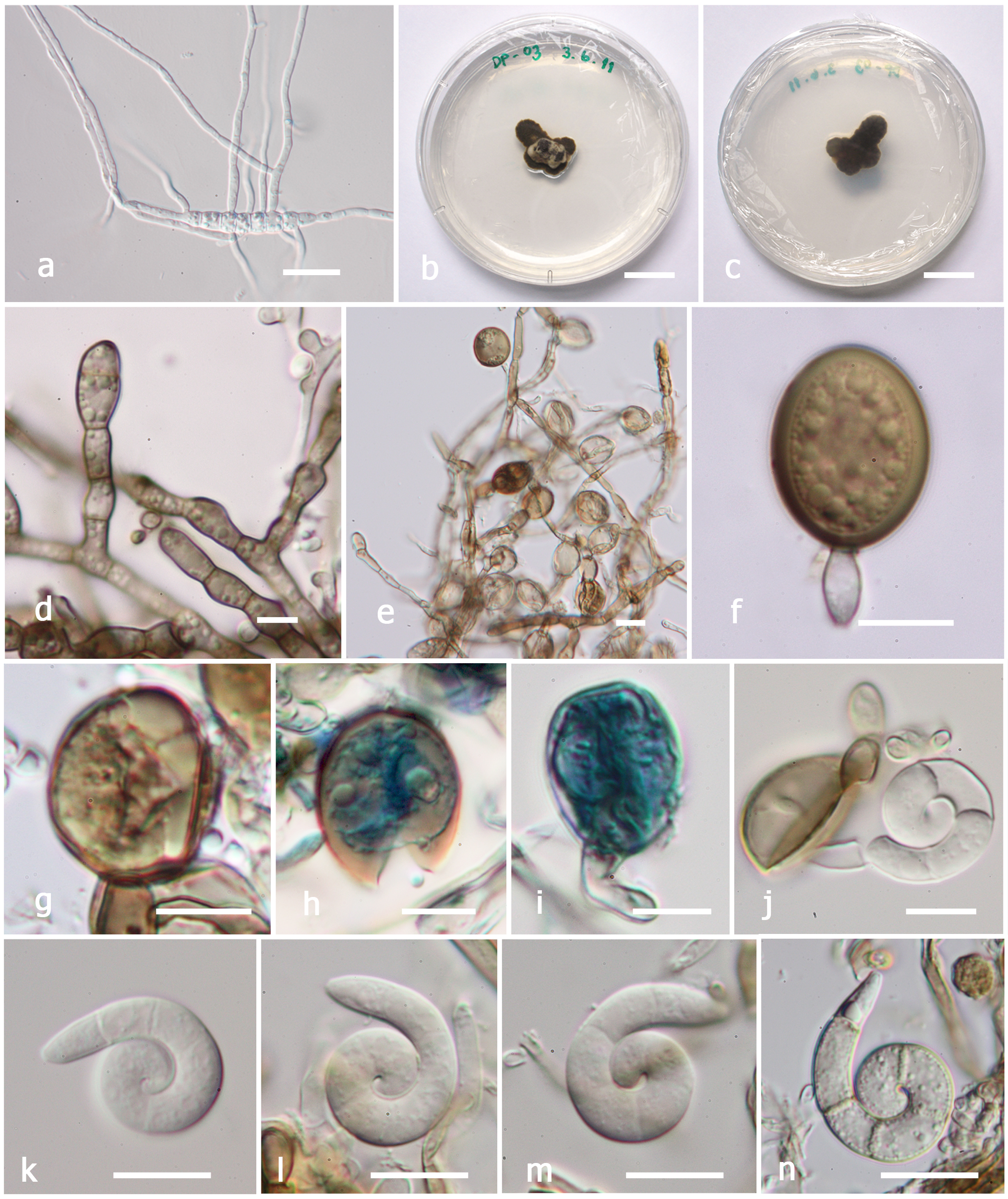Helicangiospora lignicola Boonmee, Bhat & K.D. Hyde, sp. nov.,
Index Fungorum number: IF550575, Facesoffungi number: FoF 00177
Etymology: From ligninreferring to wood and -icola meaning associated with in reference to growing on wood.
Holotype: MFLU11–0137
Saprobicon dead wood. Sexual state: Ascomata (216-)296–351 µm high × 266–340µm diam. ( = 286 × 308 µm), superficial, solitary to clustered, scattered, globose to subglobose, dark brown to black, with abundant setae, ostiolate. Setae stiff, tapering to an acute tip at apex, 56–77 µm long. Peridium 36–56 µm wide, composed of several outer cells of textura angularis, darkened; innermost comprising thin layers of pale brown to hyaline cells of textura subprismatica. Hamathecium comprising ca. 2 µm wide, numerous, filiform, septate, branched, hyaline pseudoparaphyses. Asci (77-)80–106 × 15–19 µm ( = 93 × 17 µm, n = 20), 8-spored, bitunicate, fissitunicate, cylindrical-clavate or saccate, with rounded apex, pedicel ca. 11 µm long, ocular chamber not apparent. Ascospores (40-)45–53 × 5–8 µm (= 47 × 7 µm, n = 20), overlapping1–3-seriate, fusiform, hyaline, slightly curved, tapering toward ends, supramedianly wider, 6–7-septate, not constricted at septum, smooth-walled. Asexual state:hyphomycetous, helicosporous. Conidiogenous cells terminal, integrated, holoblastic, globose, sometimes subglobose to oval, golden-brown to olive-brown, 12–17.5 µm diam.Conidiahelicosporous, differentiating endogenously within idiogenous cells, released by break down of wall ofconidiogenous cell, 12–17 µm diam when coiled, filaments 4–7 µm wide, 5-septate, tapering towards rounded ends, not constricted at septum, coiled once, hyaline, pale brown at maturity, mostly smooth-walled, sometimes verrucose, slightly bulging at the septa.
Cultural characteristics: Ascospores germinating on MEA within 12 h. Colonies slow growing on MEA, less than 5 mm diam in 7 days at 28C, slightly convex, with an undulate edge, white or pale brown and dark brown, white at margin.Mycelium superficial, septate, branched, smooth, pale brown, with hyphae producing erect, septate conidiophores.
Material examined: THAILAND, Chiang Rai, Muang, Doi Pui, elev. ca. 403–936 msl., on dead wood of an unidentified tree, 10 May 2011, Saranyaphat Boonmee, DP-03(MFLU11–0137 holotype; PDD 104452 isotype); ex-type living culture = MFLUCC11–0378 = BCC 52029 = ICMP 20069.
Fig. 1 Helicangiosporalignicola (MFLU11–0137, holotype). a Ascomata on substrate. b L.S. of ascoma. c L.S. of peridium. d Single seta. e Pseudoparaphyses. f-i Asci. j-l Ascospores. Scale bars: a-b=100µm, c, j-l=20µm, d=40µm, e=5µm, f-i=50µm
Fig. 2 Helicangiosporalignicola (MFLU11–0137, holotype). a Germinating ascospore. b, c Colonies on MEA from surface and reverse. d, e Mycelium and development of conidia in culture. f Conidiogenous cells. Note the formation of conidiumat this stage. g-j Endogenous development of conidium. j Release of conidium. k-n Conidia. Scale bars: a=20µm, b,c=10mm, d-n=5µm
Species


